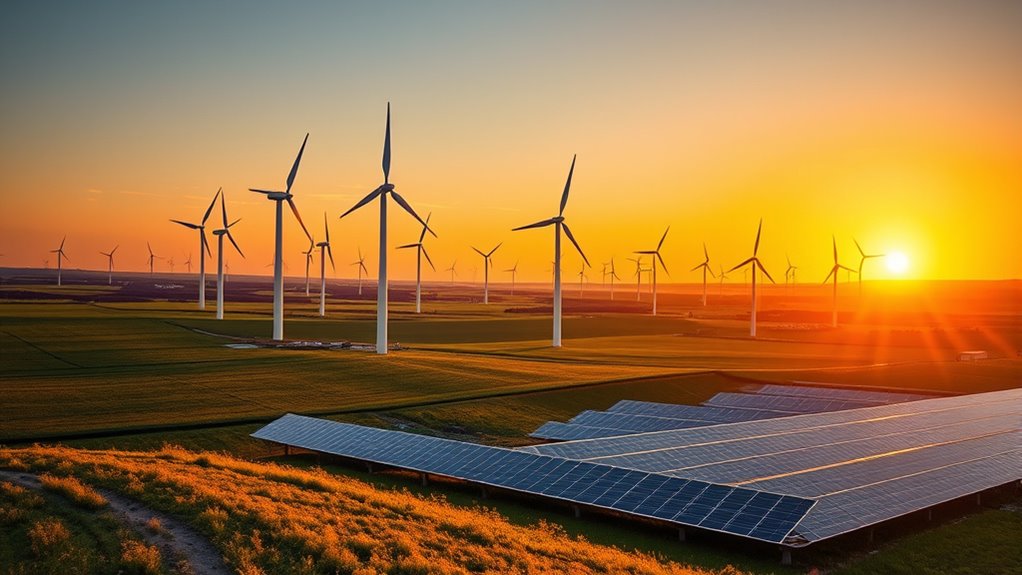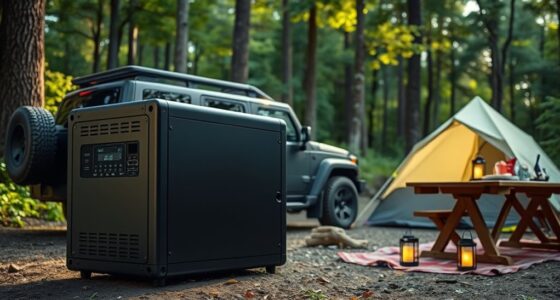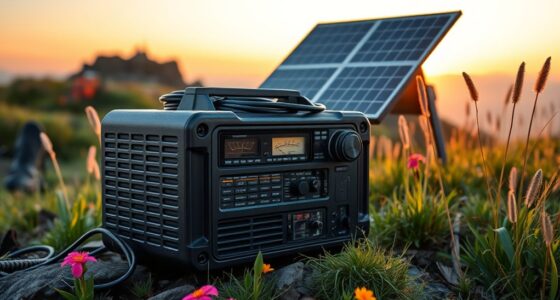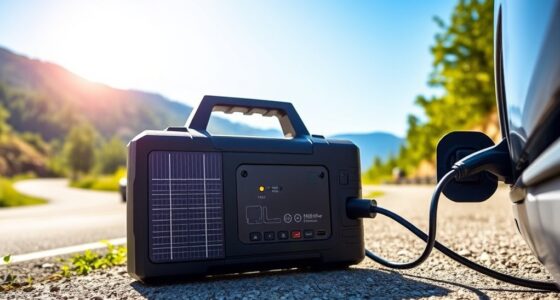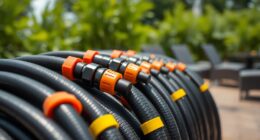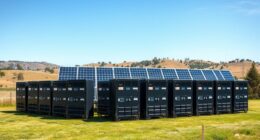Hybrid systems that combine wind turbines with solar generators give you a more reliable and efficient energy source. By harnessing both renewable resources, you can generate power during cloudy days, at night, and in low-wind periods. These systems also incorporate storage solutions and smart technology to balance energy flow and guarantee stability. Keep exploring to discover how these innovations create cleaner, resilient energy solutions that benefit your future.
Key Takeaways
- Hybrid systems combine wind turbines and solar panels to create a more reliable and efficient renewable energy source.
- Energy storage solutions like batteries help manage excess energy and ensure stable power supply.
- Grid integration allows seamless energy flow, enabling surplus energy to be fed into the grid or stored for later use.
- Diversifying renewable sources reduces weather-related power shortages and provides continuous energy generation.
- Advancements in storage and smart controllers improve system performance, cost-effectiveness, and overall energy security.
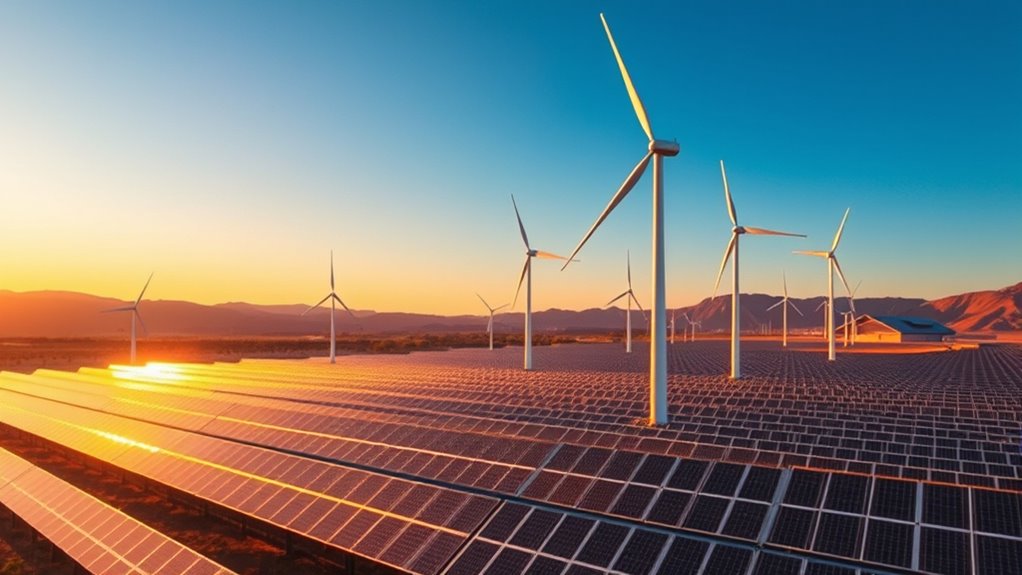
Have you ever wondered how complex systems combine different technologies to work more efficiently? When it comes to renewable energy, hybrid systems stand out by integrating wind turbines with solar generators, creating a more reliable and consistent power supply. This combination leverages the strengths of both sources, ensuring energy production continues even when one resource is less available. To maximize their effectiveness, these systems often incorporate energy storage solutions, allowing excess energy generated during peak times to be stored for later use. This not only smooths out supply fluctuations but also enhances overall system stability. Additionally, smart controllers and advanced inverters help optimize energy flow, making these hybrid systems even more efficient and adaptable.
Grid integration plays an essential role in hybrid systems, enabling seamless connection between your energy setup and the larger power grid. When the system produces more energy than needed, the excess can be fed into the grid, earning credits or reducing dependence on external power sources. Conversely, during periods of low generation, stored energy can be dispatched to meet demand, maintaining a consistent power flow. This bidirectional exchange helps balance supply and demand, making hybrid systems more resilient and efficient.
By combining wind and solar, you’re effectively diversifying your energy sources, which reduces the risk of shortages caused by weather variability. Wind turbines can generate power during cloudy days or at night, while solar panels excel during sunny periods. When integrated properly, these systems complement each other, filling in gaps and providing a steadier energy output. The integration process often involves smart controllers and advanced inverters that optimize energy flow, ensuring that storage is charged when excess energy is available and dispatched when needed.
Energy storage is crucial for maximizing the benefits of hybrid systems. Batteries or other storage technologies capture surplus energy, which can be used during periods of low wind or sunlight. This not only enhances energy security but also reduces reliance on fossil fuels. Properly managing storage and grid integration means you can optimize your system’s performance, cut costs, and reduce carbon emissions. Additionally, integrating these technologies into the grid helps utilities manage demand more effectively, leading to a more stable and sustainable energy network. Furthermore, advances in energy storage technologies continue to improve the efficiency and affordability of hybrid systems, making them more accessible for broader adoption.
In essence, hybrid systems that combine wind turbines with solar generators, supported by energy storage and smart grid integration, offer a powerful solution for cleaner, more reliable energy. They adapt to changing conditions, make better use of available resources, and connect smoothly with the larger grid infrastructure. This holistic approach makes renewables more accessible and practical, paving the way for a sustainable energy future where efficiency and resilience go hand in hand.
Frequently Asked Questions
What Are the Initial Costs of Hybrid Renewable Systems?
When you look at the initial costs of hybrid renewable systems, you’ll find that a thorough cost analysis helps determine investment needs. These systems often require higher upfront expenses due to combined equipment like wind turbines and solar panels. However, you can benefit from financial incentives such as tax credits or grants, which can offset costs. Planning carefully guarantees you understand the total investment and potential savings over time.
How Do Hybrid Systems Perform in Cloudy or Windless Conditions?
On cloudy weather and windless days, your energy system’s performance can dip because solar panels generate less power without sunlight, and wind turbines produce minimal energy without wind. However, if you have a hybrid system, it can compensate by relying on the other source. This combined approach guarantees you maintain a steady energy supply, reducing the impact of weather fluctuations on your renewable energy generation.
What Maintenance Is Required for Combined Wind and Solar Setups?
Think of your hybrid system as a garden needing regular care. You’ll want to schedule maintenance for wind turbines and solar panels to prevent dirt buildup and wear. Regular inspections extend equipment lifespan and catch issues early. Clean solar panels, lubricate moving parts, and check electrical connections monthly. Proper maintenance guarantees your system runs smoothly, maximizing energy output and avoiding costly repairs down the line.
Are There Any Government Incentives for Hybrid Renewable Installations?
You should definitely look into government grants and policy incentives for hybrid renewable installations. Many governments offer financial support to encourage clean energy adoption, including tax credits, rebates, and grants. These incentives can markedly reduce your upfront costs and make integrating wind turbines with solar generators more affordable. Keep in mind that eligibility requirements vary, so check with local agencies or energy programs to maximize your benefits and ensure compliance.
How Does Energy Storage Work in Hybrid Systems?
Oh, sure, because who wouldn’t want their energy storage to be as glamorous as a high-tech secret agent? You see, in hybrid systems, batteries are the unsung heroes, managing charge and discharge through smart battery management systems. This boosts energy efficiency, ensuring you maximize renewable power. So, when your solar and wind play nice, the batteries store excess energy, ready to power you up even when the sun’s hiding or the wind’s taking a nap.
Conclusion
By combining wind turbines with solar generators, you create a more reliable and efficient energy system. This hybrid approach can boost overall energy output by up to 50%, reducing dependence on fossil fuels and cutting emissions. Embracing this integration means you’re helping to build a sustainable future, ensuring consistent power even when the sun isn’t shining or the wind isn’t blowing. It’s a smart choice for a cleaner, more resilient energy landscape.
